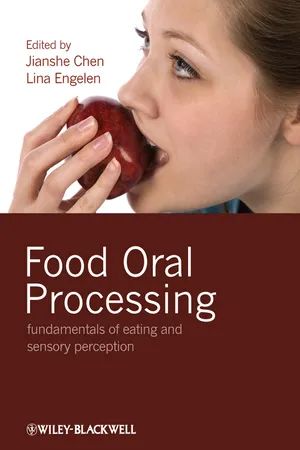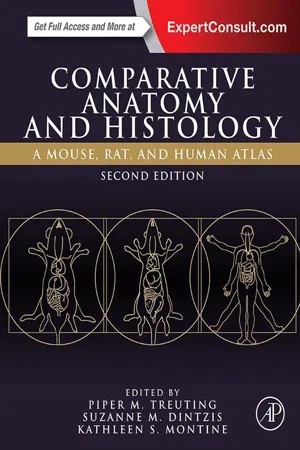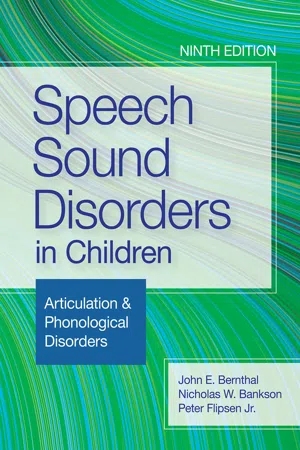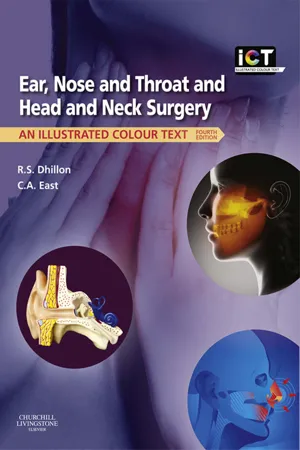Languages & Linguistics
Oral Cavity
The oral cavity, also known as the mouth, is the initial part of the digestive system and the primary site for speech production. It includes the lips, teeth, tongue, and palate, and plays a crucial role in articulating sounds and forming words in human language. The oral cavity is essential for phonetics and phonology studies in linguistics.
Written by Perlego with AI-assistance
5 Key excerpts on "Oral Cavity"
- eBook - ePub
Food Oral Processing
Fundamentals of Eating and Sensory Perception
- Jianshe Chen, Lina Engelen(Authors)
- 2012(Publication Date)
- Wiley-Blackwell(Publisher)
Part One: Oral Anatomy and Physiology 1 Oral Cavity Luciano José Pereira1.1 INTRODUCTIONThe Oral Cavity is the first part of the digestive tract. However, the mouth is not only responsible for digestive functions. It also plays a role in breathing, behavioural and social activities (talking, smiling, yawning, sucking) and taste perception. The Oral Cavity consists of two parts: the vestibule, which is limited externally by the lips and cheeks and internally by the gums and teeth; and the Oral Cavity itself (1.1), which is limited laterally and ventrally by the alveolar process and teeth and dorsally communicates with the pharynx through the isthmus faucium (Gray, 2000).Mastication is the most important function of the mouth. Teeth, muscles of mastication and salivary glands all work together to shred and break down food for swallowing. The teeth are the hardest tissues in the jaw and are involved in different activities, such as food ingestion and pronunciation of words, and also play an important role in facial aesthetics (Honda et al ., 2008; Koussoulakou et al ., 2009). The muscles of mastication promote the force needed to elevate the jaw so that food can be shredded between the teeth as the upper and lower arches come into contact (Fontijn-Tekamp et al ., 2000). Simultaneously, saliva is produced by major and minor salivary glands. The water in saliva moistens food particles and salivary mucins bind masticated food into a coherent, moist bolus that can be easily swallowed (Pedersen et al ., 2002).This chapter reviews the main anatomical and physiological aspects of the Oral Cavity – teeth, tongue, salivary glands and major orofacial muscles. The review focuses on the physiological behaviour of the mouth and fundamental knowledge of oral operations covered in four main sections: the Oral Cavity (including teeth and periodontal tissue); saliva (saliva glands, saliva secretion, composition, physical and chemical properties); orofacial muscles (location, function, activity) and tongue (tongue muscles, function). - eBook - ePub
- Phil Rose(Author)
- 2002(Publication Date)
- CRC Press(Publisher)
The Oral Cavity is bounded at the front by the lips, at the bottom by the top of the tongue (dorsum), and at the sides by the cheeks. The top of the Oral Cavity is bounded by, from front to back, teeth, hard palate and soft palate. The pharyngeal cavity is bounded by the root of the tongue (radix) at the front, and the posterior pharyngeal wall at the back. The Oral Cavity–pharyngeal cavity boundary is considered to be located at the faucal pillars, two vertical strips of tissue that can be seen, using a mirror, at the back of the open mouth either side of the pendulant uvula. One part of the pharynx is the laryngo-pharynx, or larynx-tube, which can extend from the vocal cords to the epiglottis.One of the major speech functions of the oral and pharyngeal (and nasal) cavities is to act as acoustic resonators. What this means will be explained in detail in Chapter 8 on the acoustics of speech production, but it can be noted here that during speech, especially in the production of vowels, the air in the cavities of the vocal tract vibrates in a complex way that is determined by the shape of the cavities, and that this vibratory response determines in large part the quality of the speech sound. So for a vowel like ‘ee’ [i] as in he, the Oral Cavity is relatively small, and the pharynx is relatively large. This difference in size determines in part the vibratory response which sounds like ‘ee’. With a large Oral Cavity and small pharynx the vibratory response sounds like the vowel ‘ah’ [ ] in British English father.Nasal cavity
Figure 6.5 shows the third large supralaryngeal cavity that is of great functional importance in speech – the nasal cavity. Unlike the oral and pharyngeal cavities, which are highly plastic and capable of considerable deformation, the nasal cavity is rigid. The only parts of it that can be deformed are its outlets. The external nostrils can be flared and narrowed a little, and the narrowing accompanies some (rare) speech sounds. The internal orifice is more important. Access to the nasal cavity is by means of the soft palate or velum, which is a soft tissue continuation of the roof of the mouth. The uvula dangles at its end.The velum acts as a valve. When it is open, the nasal cavity is coupled to the oral and pharyngeal cavities, air can flow through it and out through the nostrils, and the cavity can then act as an extra resonator. The muscles that are partly responsible for lowering the soft palate and thus opening the nasal port (palato-glossus) are part of the structure notionally separating the oral and pharyngeal cavities – the anterior faucal pillars – mentioned above. When the soft palate is closed, pressed up hard against the pharyngeal wall, there is no air flow through the nasal cavities, and there is effectively no nasal resonance. In Figure 6.5, the typical sickle-shape of the velum can be seen to be tightly pressed against the posterior pharyngeal wall, thus isolating the nasal cavity. Figure 6.6 shows the author’s soft palate in a lowered position, typical of quiet breathing. - eBook - ePub
Comparative Anatomy and Histology
A Mouse, Rat, and Human Atlas
- Piper M. Treuting, Suzanne M. Dintzis, Kathleen S. Montine(Authors)
- 2017(Publication Date)
- Academic Press(Publisher)
7Oral Cavity and Teeth
Piper M. Treuting, University of Washington School of Medicine, Seattle, WA, United StatesThomas H. Morton Jr., University of Washington School of Dentistry, Seattle, WA, United StatesPeter Vogel, St Jude Children’s Research Hospital, Memphis, TN, United StatesAbstract
The Oral Cavity of rodents and humans has similar functions in digestion and sound production (speech). Major differences are primarily in the structure of the dentition, which reflects the divergence in diets between species. The basic components of the Oral Cavity are the same: the lips, oral mucosa, teeth, tongue, and salivary glands all begin the process of digestion.Keywords
Anatomy; human; lips; mouse; rat; Oral Cavity; oral mucosa; physiology; teeth; tongueIntroduction
The Oral Cavity of rodents and humans has similar functions in digestion and sound production (speech) (Table 7.1 ). Major differences are primarily in the dentition, which reflects the divergence in diets among species. The basic components of the rodent and human Oral Cavity are the same: the lips, oral mucosa, teeth, tongue, and salivary glands all begin the process of digestion.Table 7.1 Oral Cavity and TeethFeature Rodent Human Gross Lips Cleft between maxillary incisors Cleft lip abnormal, if present Vermillion zone Absent Present Diastemata Space filled by upper lip folding inward between first molar and incisors Common between the deciduous incisors and cuspids of both jaws in children; uncommon between the maxillary central incisors in some adults Tongue Based at epiglottis to lower incisors, distal portion attached to floor of mouth. Dorsal roughened appearance, ventral and sides smooth - eBook - ePub
Speech Sound Disorders in Children
Articulation & Phonological Disorders
- John E Bernthal, Nicholas W Bankson, Peter Flipsen(Authors)
- 2021(Publication Date)
- Brookes Publishing(Publisher)
The basic aspects of speech production can be understood by an examination of six principal organs or subsystems, illustrated in Figure 2.2. The respiratory system, consisting of the lungs, airway, rib cage, diaphragm, and associated structures, provides the basic air supply for generating sound. The larynx, composed of various cartilages and muscles, generates the voiced sounds of speech by vibration of the vocal folds, or it allows air to pass from lungs to the vocal tract (the oral and nasal cavities) for voiceless sounds. The velopharynx —the soft palate (or velum) and associated structures of the velopharyngeal port—joins or separates the oral and nasal cavities so that air passes through the Oral Cavity, the nasal cavity, or both. The tongue, primarily a complex of muscles, is the principal articulator of the Oral Cavity; it is capable of assuming a variety of shapes and positions in vowel and consonant articulation. For articulatory purposes, the tongue is divided into five major parts: tip or apex, blade, back or dorsum, root, and body. These divisions are illustrated in Figure 2.3. The lips, along with the jaw, are the most visible of the articulators; they are involved in the production of vowels and consonants. The jaw, the massive bony structure and its associated muscles, supports the soft tissues of both tongue and lower lip. It participates in speech production by aiding tongue and lip movements and by providing skeletal support for these organs - eBook - ePub
Ear, Nose and Throat and Head and Neck Surgery
Ear, Nose and Throat and Head and Neck Surgery E-Book
- Ram S Dhillon, Charles A. East(Authors)
- 2012(Publication Date)
- Churchill Livingstone(Publisher)
The ThroatAnatomy and physiology
This section will discuss the non-neoplastic diseases of the throat. The regions included in the broad term ‘throat’ are:Oral Cavitypharynxlarynxmajor salivary glands.Oral Cavity
The Oral Cavity is frequently called the mouth but, in fact, also comprises the anterior two-thirds of the tongue, the lips, hard palate, teeth and alveoli of the mandible and maxilla. Its major function is to provide the milieu for satisfactory mastication.The tongue (Fig. 3.1 ) is a mass of interlacing muscle contained in a bag of cornified squamous epithelium. It contains numerous taste buds and is essential for efficient articulation, mastication and deglutition.Fig. 3.1 Anatomy of the tongue.The teeth provide the mechanics for grinding food and are composed of enamel, dentine and cementum. The primary dentition of 20 teeth is completed by about 3 years. There are 32 teeth in the secondary (permanent) dentition commencing at about 6 years and complete by about 18 years (Fig. 3.2 ). The teeth-bearing alveoli of the maxilla are intimately related to the maxillary sinus. Occasionally the roots of the teeth may rest within the sinus cavity and lead to sinusitis secondary to dental disease.Fig. 3.2 Primary and secondary dentition. In the completed primary dentition, each one-quarter jaw contains five teeth. In the completed secondary dentition, each one-quarter jaw contains eight teeth.As food is masticated it is mixed with saliva and formed into a bolus which is swallowed after the soft palate has occluded the nasopharynx from the oropharynx. This is the oral phase of deglutition (first stage) and is voluntary.Pharynx
For clinical purposes the pharynx is divided into three regions:nasopharynxoropharynxhypopharynx.It stretches from the base of the skull above to the cricopharyngeal sphincter below. The oropharynx and hypopharynx, although primarily concerned with swallowing, are so closely related to the laryngeal inlet that pathology in these areas may cause symptoms and signs in adjacent regions. The important clinical structures in each part of the pharynx are shown in Figure 3.3
Index pages curate the most relevant extracts from our library of academic textbooks. They’ve been created using an in-house natural language model (NLM), each adding context and meaning to key research topics.
Explore more topic indexes
Explore more topic indexes
1 of 6
Explore more topic indexes
1 of 4




